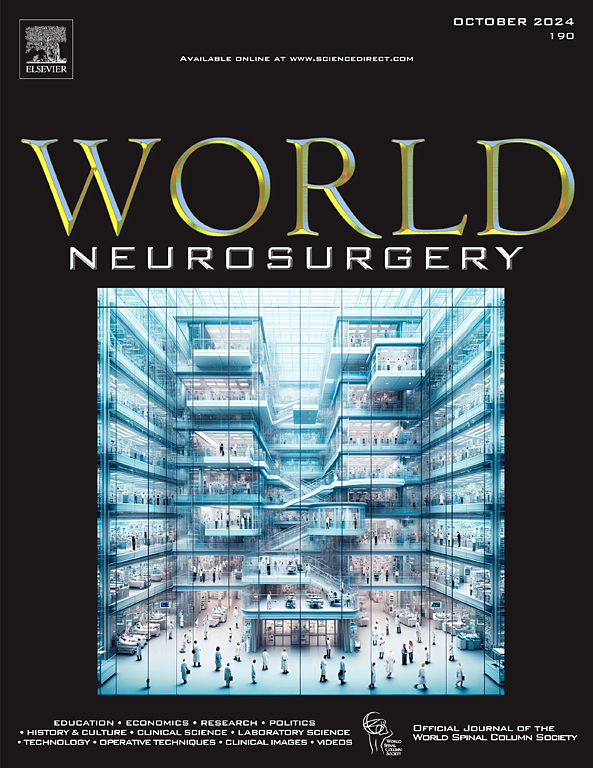基因组分析和甲基化分析胸椎脑膜瘤的机构经验。
IF 1.9
4区 医学
Q3 CLINICAL NEUROLOGY
引用次数: 0
摘要
目的:脊髓脑膜瘤的诊断率低于颅内脑膜瘤。虽然肿瘤生物学的最新进展已经通过靶向测序确定了脊髓脑膜瘤的关键驱动基因,但很少有研究尚未表征这些肿瘤的基因组图谱及其甲基化特征。在这项研究中,我们介绍了我们对8例胸椎脑膜瘤进行基因组和表观遗传学联合分析的机构经验。方法:对8例原发性脊髓脑膜瘤进行靶向基因组测序和DNA甲基化分析。通过回顾性图表复习,进一步收集相关临床资料及肿瘤影像学资料。结果:所有肿瘤样本的特征为WHO一级硬膜内髓外脑膜瘤,定位于胸椎。靶向基因组测序揭示了脑膜瘤驱动基因NF2(62.5%)、AKT1(12.5%)和SMARCB1(25%)的突变,以及参与各种信号通路的基因的一些突变。DNA甲基化分析将6个样本分类为良性特征,2个具有中间特征。所有患者均行手术切除肿瘤治疗,临床随访及影像学均未见肿瘤复发及明显残留症状。结论:我们的数据与先前的研究一致,表明尽管胸椎脑膜瘤的临床表现看似相同,但其基因组和表观遗传学景观却存在差异。了解和识别分子基础可以导致更精确和临床意义的脊髓脑膜瘤分类,这可以进一步促进有针对性和改进的治疗策略的发展。本文章由计算机程序翻译,如有差异,请以英文原文为准。
An Institutional Experience of Genomic Analysis and Methylation Profiling of Thoracic Spinal Meningiomas
Objective
Spinal meningiomas (SMs) are less frequently diagnosed than intracranial meningiomas. While recent advancements in tumor biology have identified key driver genes in SMs through targeted sequencing, few studies have yet to characterize the genomic profiles of these tumors together with their methylation signatures. In this study, we present our institutional experience of a combined genomic and epigenetic analysis of 8 thoracic SMs.
Methods
We performed targeted genomic sequencing and DNA methylation profiling on 8 primary SMs. We further collected relevant clinical information and tumor imaging through a retrospective chart review.
Results
All tumor samples were characterized as World Health Organization Grade I intradural extramedullary meningiomas localized to the thoracic spine. Targeted genomic sequencing revealed mutations in meningioma-driver genes Neurofibromatosis type 2 (62.5%), AKT1 (12.5%), and SMARCB1 (25%), in addition to several mutations in genes involved in various signaling pathways. DNA methylation profiling classified 6 samples with a benign signature and 2 with an intermediate signature. All patients were treated through surgical excision of the tumor, and clinical follow-up and imaging demonstrated no tumor recurrence or significant residual symptoms.
Conclusions
Our data, in concordance with prior studies, demonstrate a diverse genomic and epigenetic landscape of thoracic SMs despite a seemingly homogenous clinical presentation. Understanding and identifying the molecular underpinnings can lead to a more precise and clinically significant classification of SMs, which can further contribute to the development of targeted and improved therapeutic strategies.
求助全文
通过发布文献求助,成功后即可免费获取论文全文。
去求助
来源期刊

World neurosurgery
CLINICAL NEUROLOGY-SURGERY
CiteScore
3.90
自引率
15.00%
发文量
1765
审稿时长
47 days
期刊介绍:
World Neurosurgery has an open access mirror journal World Neurosurgery: X, sharing the same aims and scope, editorial team, submission system and rigorous peer review.
The journal''s mission is to:
-To provide a first-class international forum and a 2-way conduit for dialogue that is relevant to neurosurgeons and providers who care for neurosurgery patients. The categories of the exchanged information include clinical and basic science, as well as global information that provide social, political, educational, economic, cultural or societal insights and knowledge that are of significance and relevance to worldwide neurosurgery patient care.
-To act as a primary intellectual catalyst for the stimulation of creativity, the creation of new knowledge, and the enhancement of quality neurosurgical care worldwide.
-To provide a forum for communication that enriches the lives of all neurosurgeons and their colleagues; and, in so doing, enriches the lives of their patients.
Topics to be addressed in World Neurosurgery include: EDUCATION, ECONOMICS, RESEARCH, POLITICS, HISTORY, CULTURE, CLINICAL SCIENCE, LABORATORY SCIENCE, TECHNOLOGY, OPERATIVE TECHNIQUES, CLINICAL IMAGES, VIDEOS
 求助内容:
求助内容: 应助结果提醒方式:
应助结果提醒方式:


